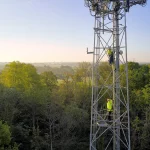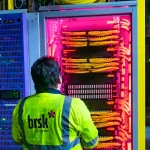75% of UK to Have Choice of Three Gigabit Broadband Networks by 2030

A new Point Topic forecast of fixed line ISP network coverage, which considers both the impact of “full fibre” (FTTP/B) and Cable (DOCSIS 3.1) networks, has predicted that gigabit-capable networks will cover around 97% of the UK by 2030 and the majority of postcodes (75%) will also have the choice of up to three gigabit networks.
The UK telecoms regulator, Ofcom, recently reported (here) that gigabit-capable (1Gbps+) services are now available to 68% of UK premises, which is higher than the “full fibre” FTTP figure (37%). The latter is because most of the recent growth in gigabit connectivity has flowed from Virgin Media’s completed upgrade to their existing Hybrid Fibre Coax (HFC) lines with DOCSIS 3.1 technology.
At present the lion’s share of this gigabit coverage comes from Openreach, Virgin Media (VMO2), Cityfibre and Hyperoptic, although a mass of smaller alternative networks (AltNets) and also rapidly deploying across various different parts of the United Kingdom (Summary of UK Full Fibre Builds).
Advertisement
As part of this we’re also seeing a rising level of overbuild between networks, particularly in the naturally competitive urban areas (cities and towns), which past studies (example) have indicated may be capable of supporting as many as four or more gigabit-capable networks. But the level of overbuild tends to diminish in less competitive areas (rural villages and smaller towns), where the economic model for investment is put under more strain.
Point Topic are now projecting that the majority of UK postcodes, around 75%, will have a choice of up to three gigabit networks by 2030. Furthermore, there are more than 20% where the current plans and operators in the market mean four or more networks in a postcode. But it’s not all good news because 17.6% of UK households will only have access to just one gigabit capable network, while 3% will go without any gigabit networks.
The 3% without gigabit typically suggests a UK gigabit coverage level of around 97% by 2030, which is interesting because that’s below the target in the UK Government’s new £5bn Project Gigabit programme. This aims to help extend gigabit coverage to at least 85% of UK premises by the end of 2025 and then “nationwide” by 2030 (in practice this tends to mean c. 99% as we already know that around 0.3% may not be reachable).
However, there’s a natural degree of rising uncertainly when you try to model such deployments out to 2030, although we tend to agree with Point Topic’s assessment. The analyst also correctly notes that not all of the deployment ambitions by operators will be successfully executed. The current version of their model predicts the deployment of FTTP to a postcode by any operator with an accuracy of just over 70%, so keep that in mind.
Advertisement
On the other hand, even pushing gigabit-broadband coverage to above 90-95% would be a pretty spectacular achievement by 2030, so if the UK can get to 97%+ then that’s still nothing to sniff at.
Mark is a professional technology writer, IT consultant and computer engineer from Dorset (England), he also founded ISPreview in 1999 and enjoys analysing the latest telecoms and broadband developments. Find me on X (Twitter), Mastodon, Facebook, BlueSky, Threads.net and Linkedin.






















































Curiosity led question.
What are those 0.3% who “may not be reachable”? There is a world of difference between not-reachable and not-commercially viable (though the practical upshot is the same of course). I can’t think of any scenario where people are completely non-reachable though that might cost in the millions to do.
“I can’t think of any scenario where people are completely non-reachable though that might cost in the millions to do.”
I am not a business owner, but I would class that as non reachable. Multiple millions just to provide cable to a single cottage in the middle of nowhere. I would say amounts to unreachable.
Relevant articles:
https://www.ispreview.co.uk/index.php/2022/02/gov-ponders-approach-to-gigabit-broadband-in-remote-uk-areas.html
https://www.ispreview.co.uk/index.php/2022/11/government-start-uk-leo-satellite-trials-to-fix-rural-broadband-woes.html
Thanks both it’s just the pedant in me. Doesn’t really mean non-reachable, just means non-viable. Two completely different meanings though as I said the result is the same of course.
Anyone would think infrastructure competition rather than either an Openreach hegemony or an Openreach / VMO2 duopoly is a good thing the way this is phrased.
Clearly what we need is marginally cheaper Openreach in the 25% and zero alternative options with Openreach charging whatever in the 75%, right?
What does “and the majority of postcodes (75%) will also have the choice of up to three gigabit networks” mean? Surely everywhere in the UK (and indeed worldwide) has the choice of up to 3 gigabit networks as, when I last checked, zero falls within “up to three”.
From the linked article, I think what they are trying to say is that by 2030 75% of postcodes will have a choice of 3 or fewer gigabit services. That is a very odd thing to say – a more positive spin (depending on your agenda of course) would be to say that by 2030 more than 45% of postcodes will have a choice of 3 or more gigabit networks.
I think it’s more likely that 75% of postcodes will have a choice of two or three gigabit networks by 2030. I’d expect around 50% of households to have a choice of at least two gigabit networks by the end of 2025.
6G mobile network download speeds would pee all virgin media in 2030 .
Yes but they will cost a fortune.
At the rate at which 5G is being rolled out to an extent of actually delivering a meaningful improvement over 4G, it’ll be next century before 6G produces any meaningful benefit for consumers at a sensible price!
Can’t wait. Right now I have a choice of any gigabit provider so long as it’s Virgin Media and their prehistoric upload speeds. In a few years I’ll have a choice of BT/OpenReach, CityFibre, and Upp. The sooner I get Virgin Media out of my life the better.
We only had Virgin media in our estate in Plymouth, in the last 6 months or so both Openreach and Cityfibre have installed along our street and are both live. Our Openreach FTTP (BT) is so much better than Virgin IMO.
Duplicating or triplicating infrastructure when a minority of UK consumers are being told it’ll be decades or never until they get proper broadband is a total failure of policy/regulation. Regulation exists to sort out the deficiencies of unfettered markets, but as usual government (it won’t be Ofcom making the decisions) have gone for the worst available solution. Plenty of money across the telecoms industry to deliver high speed broadband to those hard to reach locations (we do this already by cross-subsidy to deliver roads, electricity and water), instead they’ve allowed value destroying multiplication. I’m not arguing for zero duplication at all (definitely not, as a long suffering Virgin Media prisoner), merely observing that the choices made are poor, and probably have the usual causes of lazy, poorly qualified ministers who don’t understand enough about the sector they are responsible for, and who never ever take a long term or national interest perspective.